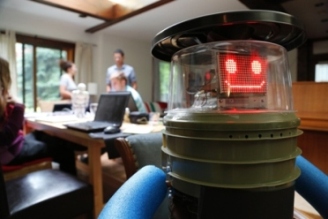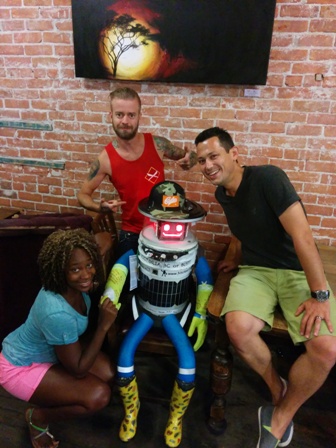Something strange has been happening across Canada. A small, chatty robot has been making its way from Halifax to Victoria by waiting on the side of the road to hitch rides. On August 16, hitchBOT tweeted out to its followers that it was on the ferry to Victoria, marking the end of its journey.
A day earlier, the Federation had the chance to speak to the creative minds behind hitchBOT. These are David Smith, Assistant Professor in the Department of Communication Studies and Multimedia at McMaster University, and Frauke Zeller, Assistant Professor at the School of Professional Communication at Ryerson University. We were curious about the role that the humanities and social sciences played in the creation of hitchBOT.
For Smith, hitchBOT is primarily an art project that breaks with traditional curatorial practice to become a moving exhibition, propelled both physically and digitally by its social momentum. This particular facet of the artwork equally positions it as an inquiry in social robotics or, in other words, human-robot interaction.
Zeller, who wrote her PhD dissertation in linguistics on human-robot interaction, was curious to find out “are people willing to interact with robots” and what shape would that interaction take? This is particularly intriguing considering that hitchBOT was placed in an unusual cultural setting that perhaps no robot has had to navigate before. Can robots in such settings trust humans?
The results have been overwhelming. Not only was hitchBOT able to complete its journey in three weeks, but a quick survey of its Twitter feed reveals that the robot has been invited to meals, parties, a wedding in BC and an Anishinaabe powwow on Manitoulin Island. In response to this warm reception, hitchBOT will likely continue traveling around Canada to visit even more people and places following its primary journey.
Smith and Zeller attribute this success to an effectively crafted social media strategy that helped give hitchBOT life and character. In fact, social media is part and parcel of hitchBOT’s identity. According to Smith, who studies emerging media formats, “[the physical hitchBOT] is just a pinpoint of an entire inversed pyramid of social media presence; this reshapes our thinking about the potential of these cloud-connected robotic devices.”
Here, the humanities and social sciences have been indispensible to the researchers. Their background in communication, media and linguistics has had a profound influence on how and what hitchBOT communicates, as well as the clever social media strategy behind the robot's quick rise to fame. The full team behind hitchBOT includes students and researchers in the social sciences, the humanities, engineering, mechatronics and computer science.
“hitchBOT is a unique example of how [the social sciences and the humanities] matter in terms of stimulating interdisciplinary work but also reaching out and achieving fantastic public engagement and interest in what we do,” says Zeller.
She says that it is an example of how academia can “engage people and stimulate their creativity.”
The First Nations of Canada have also expressed great interest in HitchBOT as “a wonderful focal point to have discussions [about technology] and also to stimulate the younger generation to open up these areas of inquiry for themselves,” says Smith. In this way, the humanities and social sciences help pique future generations' interest in technology.
There is even a lesson for politicians in hitchBOT’s communication strategy.
“There is quite some craftsmanship behind [hitchBOT’s communication strategy]…this is certainly one additional genuine thing from the social sciences and humanities [for policymakers],” says Zeller. “We do know the theories behind it and also the applied approaches of how to engage the public and I think that’s a very valuable knowledge.”
In the end, academia as a whole wins for being inclusive of all disciplines, and valuing the unique appeal of the social sciences and the humanities in reaching the general public.
Listen to the full interview with professors David Smith and Frauke Zeller here.



